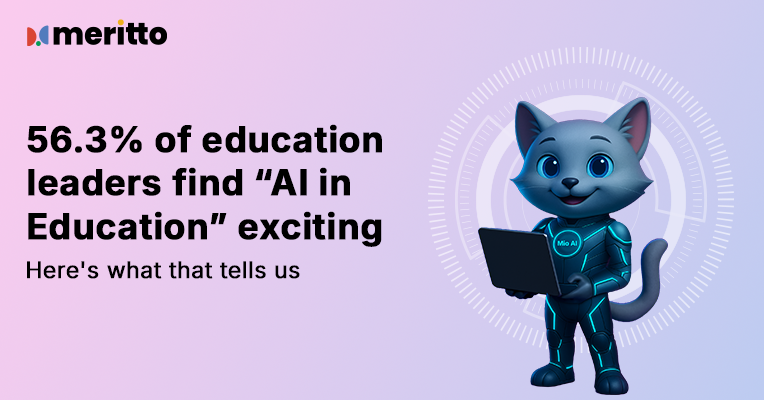In a recent survey, we asked education leaders how they feel when they hear the phrase “AI in education.” The results were telling: 56.3% said they feel excited, and 43.8% said they feel curious. Not a single respondent expressed fear or resistance.
This kind of response marks a turning point. AI is no longer a distant concept sitting on the fringes of higher education strategy. It is increasingly being seen as a powerful enabler, something institutions are genuinely enthusiastic to explore. But what is driving this sense of excitement? And how should institutions channel it?
Let’s take a closer look at what this sentiment reveals and where the road may lead from here.
From conversation starter to strategic priority
For years, artificial intelligence has appeared in higher education panels, whitepapers, and tech showcases. Yet, for most institutions, it remained just that: a conversation. It generated curiosity, but not necessarily commitment.
Today, that is changing. AI is no longer seen as just another technology layer. It is now being considered in direct response to some of education’s most pressing operational and engagement challenges. Institutions are beginning to ask important, grounded questions.
How can we offer timely responses to thousands of inquiries?
What is the best way to support multilingual communication at scale?
How do we ensure students stay informed, guided, and engaged without overburdening our staff?
This shift from abstract curiosity to practical use-case thinking is part of what makes the current moment so exciting.
Why AI resonates more today than ever before
Part of the growing enthusiasm around AI comes from its relevance. The student journey is now more complex, more digital, and more demanding. From first inquiry to final enrollment, students expect institutions to be present, responsive, and helpful at every step.
At the same time, teams inside institutions are stretched thin. Many are managing increasing volumes of inquiries, multiple communication channels, and rising expectations without proportionate increases in resources or staff. This gap between capacity and expectation is exactly where AI starts to feel not just helpful, but essential.
AI has the potential to offer real-time support, reduce response times, and personalize interactions. And it can do all of this without adding pressure to existing teams. That is no longer a hypothetical benefit. Institutions are starting to see it in action.
Moving beyond automation: The need for intelligent systems
Of course, not all AI is the same. Many institutions have experimented with rule-based chatbots or simple workflow automation. These tools have their place, but they are fundamentally limited. They require pre-programmed rules, can only handle predefined scenarios, and often break down when faced with nuance.
They reduce steps, but they rarely drive outcomes. In contrast, the next wave of AI in education is not just reactive. It is agentic.
Agentic AI refers to systems that are designed to act with context, intent, and autonomy. Rather than waiting for inputs, they anticipate needs, adapt to behavior, and actively work toward outcomes. This is the kind of AI institutions are getting excited about, and for good reason.
Mio AI: A high-performance, industry-ready agentic AI
One example of this shift toward agentic systems is Mio AI, a high-performance, industry-ready AI built specifically for education. Rather than functioning as a tool that needs constant prompting, Mio AI operates as a digital teammate. It is integrated, intelligent, and capable of working alongside human teams to solve real enrollment and engagement challenges. Mio AI supports:
- Lead capture and qualification on your website
- Real-time, multilingual support in your student portals
- Intelligent nudges and query resolution during applications
- Continuous learning through your own content (FAQs, docs, policies)
- A personalized experience aligned to your institution’s brand and tone
What makes it stand out is not just what it can do, but how it works—autonomously, contextually, and at scale. It reduces drop-offs, improves response times, and frees up your team to focus on high-value work.
Institutions using Mio AI have already seen:
- Up to 70% gains in operational efficiency
- Over 60% of student queries resolved without human intervention
- Significant improvement in student experience and onboarding speed
Mio supports multiple use cases across the student journey. On institutional websites, it engages prospective students in personalized, context-aware conversations, capturing leads, qualifying intent, and resolving queries in real time. Within student portals, Mio provides multilingual support, prompts next steps, reduces drop-offs, and helps students move forward with clarity and confidence.
All of this is powered by Mio’s Core knowledge engine, which continuously learns from institutional content such as FAQs, policies, and documents to ensure brand-aligned and up-to-date responses. Teams also gain access to insights into student behavior, AI performance, and areas of improvement, enabling smarter decisions over time.
Most importantly, Mio is not just functional. It is fast to activate, requires no code, and is designed to reflect each institution’s brand, tone, and personality. From language to interface, it adapts to regional contexts and student expectations.
A shift worth paying attention to
The fact that more than half of education leaders feel excited when they hear “AI in education” is more than a sentiment. It is a signal. It shows us that institutions are ready, not just to talk about AI, but to implement it in meaningful, student-first ways.
Agentic AI, like Mio, represents the next step forward. It is not replacing people. It is enabling them to do more of what matters. It is removing friction, amplifying support, and helping institutions operate at a higher level without more effort.
Excitement is a great place to start. But now, with systems like Mio, institutions finally have a way to turn that excitement into action.
